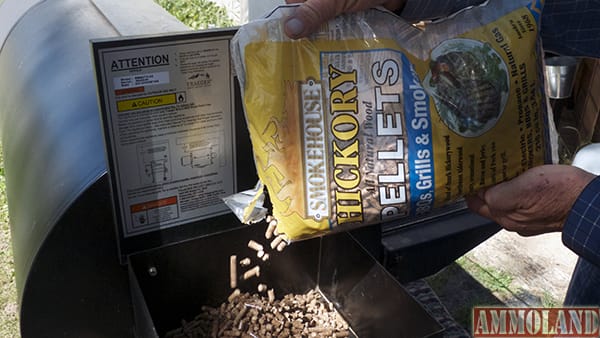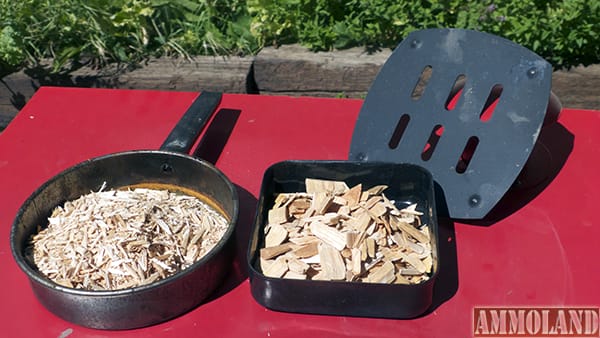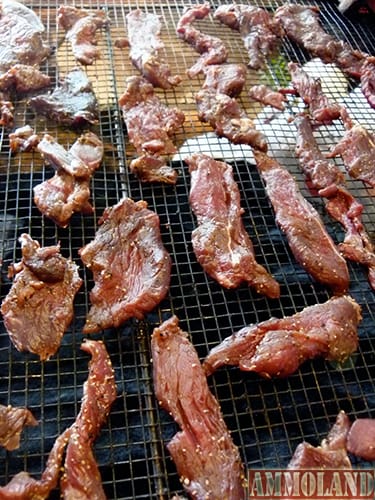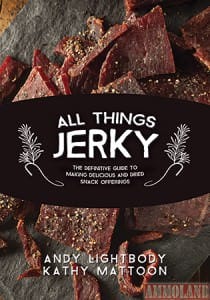Plan your wood flavors properly, and you’ll never get burned!
By Andy Lightbody and Kathy Mattoon Authurs of All Things Jerky


United States -(AmmoLand.com)- Years ago, there was a TV commercial about how “a day without orange juice, was like a day without sunshine.”
Bring that philosophy into the world of smoking meats, fish, poultry, sausage, jerky, vegetables and other favorite eats, and it ought to translate to… a smoker without good wood is nothing but a low temperature oven!
Good wood for all your smoking adventures is absolutely critical to the process of turning out everything that comes off your BBQ or out of your smoker. Use woods that are not designed for smoking or BBQing, and at minimum you are likely to cook otherwise well prepared foods that the dog is going to run away from. Or, you’re going to make yourself extremely sick with toxic and noxious resins, paints or chemicals.
In the world of woods used for meat or fish smoking, there are literally hundreds of species throughout the globe that have been used over the last several million years. Today, there are dozens of wood types that are commercially available to the backyard BBQer, each with an often distinct flavor that compliments a variety of different meats and delicacies. Many say it is somewhat like choosing the right wine (red or white) and then selecting that perfect flavor (sweet, dry, mild, or bold).

In many ways, it probably is, but without the “snootiness” of having to be a grape snob!
To begin with, let’s look at what types and kinds of woods that should never be used for smoking! Many of these may be okay for the campfire or for outdoor pot/pan cooking, but these should be avoided for use when smoking:
* Conifer/Evergreen wood—pine, fir, spruce, redwood, cedar, sweet gum, and cypress. They are loaded with resins that are bitter, will ruin your meats, your smoker… and can make you sick!
* Wood pallets—these are often treated with chemicals or poison.
* Scrap lumber/old furniture or painted/stained wood—paint with plastics or lead, stain, poly coatings, and poisonous chemicals are going to mess up your food flavors and likely make you ill.
* Old woods, even smoking favorites if they are covered in mold or fungus. They are likely in impart a bad/nasty taste to your meats.
* Others to avoid—Elm, Eucalyptus, Sassafras, Liquid Amber and Sycamore.

And while we are on the subject of “what not to use,” let’s also dispel the old wife’s tale about wet wood versus dry wood. Dry wood is always, always going to give you better results. After all, you want your chips, chunks and pellets to semi-ignite and smolder.
Remember, that’s why it is called wood smoke!
Adding moisture to your wood, or presoaking it does nothing but slow the smoking (burn/smoldering) process and can cause a very uneven burn of the woods in your wood pan or receptacle. If your wood is heating too quickly and simply igniting into flames, your heat source or heating element is just way too hot. Move your chips/chunks a little further away from the gas or electric element, or even try to use a metal pan to disperse the heat and that direct contact, while adding a little layer of insulation. Don’t water your woods!
Another word of caution is… don’t over-smoke your meats and foods. Sometimes, less is more. While you want to taste the smoke flavor and have it compliment your meats, you don’t want it so, so overpowering that the flavor of the meat is gone. Many of us have had these offerings that we simply call Smokey the Bear forest fire remains.
This guide will help explain some of the most common and commercially available wood varieties and the flavors they impart when used for smoking. There are no hard and fast rules, and there is really no ONE wood that is the BEST. Each type has its own flavor profile, and burn/smoke characteristics. Just like selecting a favorite wine, it often comes down to personal tastes and preferences.
Many of the commercial bags of wood chips, chunks and pellets, such as those produced by Smokehouse Products are actually a blend of wood types. Their Alder flavored wood is 100% “alder only,” but their others are actually a blend that uses a mix of alder with other wood flavors such as Hickory, Mesquite, Cherry, and Apple. Regardless of your favorite flavor or wood type, always make sure that the woods used are all-natural and contain no artificial flavorings, chemicals or preservatives! A lot of their woods are available through most of the big-box sporting goods stores, or directly from their website at www.smokehouseproducts.com.
In some cases, “wood connoisseurs” will actually blend or combine several types for different tastes. If you’re starting from scratch, experimentation is a good thing. It’s also a good idea to keep a log book or journal of your smoking attempts and adventures.
THE FAVORITE WOODS AND FLAVORS

Hickory:
This wood is the “King” of smoking woods and is the most popular of all the types. It is a hardwood that puts off a heavy, pungent and some say bacon-like smoke flavor. It’s most popular for smoking ham, bacon, pork roasts, sausages, big game steaks and jerky. Its flavor is strong, so use it sparingly until you figure out what suits your taste buds.
Apple:
It was originally most well-liked in the northern U.S., but has grown to be the second most popular wood smoke flavoring across America. It has a slightly sweet taste that is ideal for smoked turkey, chicken, poultry, game birds and even waterfowl. It has the strongest flavor in the fruitwood category, and is great for pork, ribs, sausage and any game bird jerky.
Mesquite:
Once considered little more than a “thorny and nasty Devil Tree,” this scrubby tree/shrub is now the third most popular BBQ and smoking flavor in the nation. Seven different species inhabit the American Southwest and it’s praised for its strong flavor which is characterized as being a little sweeter and milder than hickory. It’s a top choice for pork, beef, lamb, poultry, big game and jerky. Mesquite is a favorite for also making smoked almonds, pecans, and other nuts.
Alder:
A longtime favorite throughout the Pacific Northwest, it is a mild-flavored wood that is the “top favorite” for salmon, trout and virtually all fresh and salt water fish. Alder imparts a light, delicate smoke flavor that enhances but does not overpower the natural taste of fish. It’s also excellent for pork, chicken/turkey, game birds and waterfowl.
Cherry:
A favorite fruitwood that is ideal for a sweet, full-bodied flavor for beef, big game, waterfowl and jerky. It’s also a great choice for cold-smoked cheeses. It is most popular in the Northwest and Northeast United States.
Oak:
It’s a popular favorite with a “middle of the road” flavoring that is lighter and more delicate than hickory and great for smoking pork, beef, BBQ ribs and poultry. It’s one of the most popular woods used throughout the country in BBQ restaurants, as it seems to please a wide variety of pallets and taste buds. Ground up old whiskey and wine barrels are often considered a prized fine by smoking wood aficionados!
Pecan:
A favorite throughout the Southeastern U.S., pecan has a strong and nutty flavor that works great with pork, turkey, and other game birds. Not as strong as hickory and a little sweeter.
Citrus:
Obviously most popular in the states where they grow lots of orange, grapefruit, nectarine, lemon and lime trees. This family of citrus wood has a light sweet and tangy flavor that works great on all types of fish, turkey, chicken and light-meat game birds.
Sugar Maple/Birch:
These woods are a medium-hard wood that add a light and subtle smoke that works well with game birds, pork and fish. Sugar maple is a favorite for salmon and trout. Because the flavor is light, it often requires more chips or chunks than with some of the stronger flavored woods.

As you will soon discover, there are lots of other wood types out there and available commercially. Some are good and interesting. Others should be avoided like the plague! In our travels around the globe, we’ve had smoked meats, fish, poultry, sausage and jerky made with everything from the Colorado Aspens and Illinois corn cobs, to Manzanita from Mexico, Malaysian sugar cane and African Baobabs and Marula trees.

What’s really great about trying all of these unusual offerings, is that when it’s time to come home to smoke, cook and BBQ, you even more greatly appreciate all the quality and consistent wood flavors in the Smokehouse chips, chunks and pellets. The hard work and blending is already done for you, and all you have to do is cut open the bag, and pour!

About the Authors:
Andy Lightbody and Kathy Mattoon are lifetime outdoor folks/conservationists that hunt, fish and love to cook and share their game, fish and award-winning recipes from the field. Andy was Senior Editor for Petersen’s Hunting Magazine,
Editor of the Outdoor Book Division for Guns and Ammo, and is a TV host for Rocky Mountain Television, a Field Editor for AmmoLand.com and Sportsman’s News Magazine. Kathy is a Producer/Videographer for Rocky Mountain Television and hosts the TV/video production– Cookin’ On The Wild Side.
Both are co-authors of the book, ALL THINGS JERKY… the definitive guide to making delicious jerky and dried snack offerings! (Skyhorse Publishing Company, 2015). Books are available online through Amazon.com.
